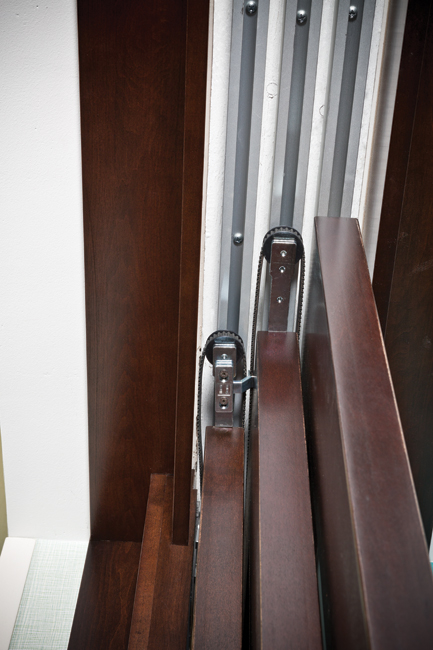Open Sesame: Specifying Top-Hung Sliding Hardware Systems
Primary Systems and Applications
Perhaps the architect has heard the terms—pocket door or sliding bypass—or perhaps the terms multi-slide and multi-fold are unfamiliar. Whether or not one uses the terms, designers can apply these valuable concepts to the schematic and design development phases to make their building environments more functional, efficient, and experiential. So what are basic system types and application types?
The first consideration is architectural need and function. For example, is the requirement a door opening where sliding hardware affords various advantages? If it's conceived as a moveable wall, does the sliding system fold or stack? Another common use is for furniture, where the casework or storage areas can be hidden behind translucent or opaque panels. And for the exterior envelope, can matching outdoor shutters enhance building function?
A second consideration is that applications have a lot to do with how the panels move. Do they only move in a straight line, or do they curve? Just one panel that slides straight, or multiple door panels? If multiple, are they in the same track or in multiple tracks?
Third, consider the hardware system: Why would top-hung or bottom-supported systems be more suitable, durable, and effective? For the top-hung types, the weight of the panels and frames are supported by top track. Bottom rolling systems use the track at the floor or base to support the panels' weight and allow for movement.
Characteristics of top-hung versus bottom-rolling systems, in addition to those mentioned previously, are worth discussion during project design development. For top-hung systems, a recessed and concealed top track above the ceiling plane is possible. The top-hung products generally require less force to move the panels, and the trolleys remain in continuous contact with the tracks. A wide range of curvilinear movements and curved panels can be used. At the floor plane, the finished look imparts clean continuity: It allows for a clear threshold, and it's easier to deal with unlevel floor conditions.
Bottom-rolling systems have a few clear advantages. The main one is that the systems can achieve very high load capacities using relatively simple hardware. However these bottom-rollers require a bottom track, surface-mounted or mortised into the floor that must be as level as possible. On the downside, bottom-rolling hardware is prone to malfunction where the rolling elements, or sheaves, jump the tracks. Installation may be complicated by any uneven floor surfaces; in terms of operation, the presence of the track in the doorway can limit uses, and the bottom track can collect dirt and debris, impairing door movement over time.
Using selections from the above key criteria—function, movement options, and hardware type—the architect can determine the most effective configurations for the openings. Common arrangements of the sliding doors and panels include the two most basic: linear (straight path) and curvilinear (radius path) sliding systems. A single-panel, single-track assembly is the most basic linear design, while a bi-parting system uses two single panels sliding on a single track. Add a second track, and the design can accommodate a bi-directional, bi-passing configuration with two or more tracks and two or more panels that can move past each other as needed.
Sliding Wall Systems
There are two basic types of sliding wall systems: First is the sliding-and-stacking type, and second is the sliding-and-folding type. Each has its own benefits for certain situations, depending on the space allowed and end-user preferences. Understanding the mechanics and geometries of each type will help savvy architects select the most suitable and convenient door system.
For placement of retracted panels in a large opening, sliding and stacking systems utilize curvilinear track interchanges. These tracks are engineered to smoothly move and stack the panels either parallel or perpendicular to the tracks within the openings, in efficient alcoves or recessed niches often called “parking areas” in the industry. The interchanges and parking areas allow for quiet and relatively effortless maneuvering of panels into the stacking area and, if needed, by changing their direction and orientation. These systems have been used by architects and building owners to add extensive flexibility to interior environments.
In typical stacking systems, the panels operate independently and are not connected to each other. This increases the amount of movement allowed for each panel; they can slide farther and carry more weight. It also increases the flexibility of how the panels work together. When in “parked” or stacked position, they can be placed in a position parallel or perpendicular to the main track.
Unlike stacking systems, folding hardware systems feature panels that are hinged together. These allow for a large opening while the panels are moved into an open or retracted position. These systems can be specified as either center-hung—with no continuous floor channel guide needed because the panel arrangement is balanced—or edge-hung, which requires a floor guide, but does not require a half panel as in center-hung configurations.
Telescoping and Symmetrical Arrangements
The special cases of three unique types of top-hung sliding hardware systems—with the potential for unique parking area abilities and user benefits—merit a detailed review.
The first, the telescopic type of system, allows two or more panels to be moved simultaneously to the right or to the left, or both. A practical advantage of this system type is that the set of sliding panels or doors can measure, for example, twice as wide as a recess in which it is parked. So given a small pocket wall or wall segment, the designer can use the telescoping system to emerge and enclose a much larger opening with glass or wood. These systems are ideal for tight quarters in a variety of facilities, and by using glass panels they can make the spaces feel larger even when enclosed. Anywhere there is an opening larger than available panel parking area, telescoping hardware systems may be suitable.

Photo courtesy of Hawa Americas Inc.
A close-up of the telescopic type of sliding system, which allows two or more panels to be moved simultaneously to the right or to the left, or both. This allows a set of sliding panels or doors to fit in a very small recess relative to the opening width.
The second type of top-hung hardware may be informally called a mirror arrangement but is best known as a symmetrical or “symmetric” hardware. This type allows for the simultaneous opening and closing of two separate bi-parting panels or doors opposite each other, creating the appearance of a reflected or mirror effect. For user convenience, both panels open or close at the same time by simply operating either the panel on the left or the right.
Last, the third kind of hardware technology can be called a pivot/slide-in system, sometimes known as a scissor system. Seen often on wood cabinet and partition doors where the panel pivots and then slide back to a recessed position, these systems can also serve room-height doors and wall panels. The hardware does not require a bottom guide channel to optimize flexibility and utilization, but the design must allow for sufficient depth of the parking slot as well as the correct location for the fitting mounts. The hardware has been used to create “hidden offices” and storage in spaces where the occupants desire an uncluttered look while maintaining requisite function. As one Swiss manufacturer famously explained, “Everything not in use will vanish!”









